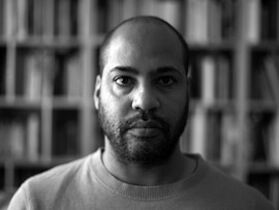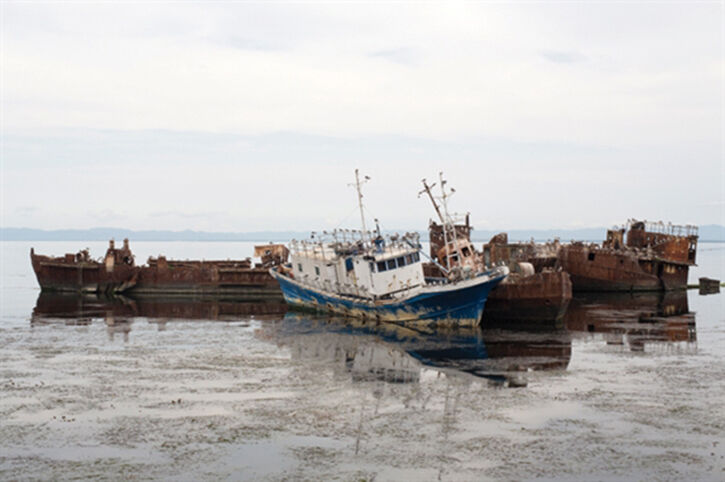
David Hartt Has a Lot on His Mind

by Jeremy Ohmes
"Our understanding of ourselves is deeply rooted in the spaces we occupy.”
David Hartt (MFA 1994) sits on a couch in the living room of his West Lakeview home. He is talking about his fascination with the built environment—how spaces reflect the ideologies and beliefs of a particular time and place.
Mad Libs are scattered across the coffee table, and the sound of shuffling feet and a cough muffles through the second floor. His son is home from school with a cold. One of Hartt’s photographs hangs on the wall, large and formidable. An off-oval glass sculpture from his 2013 exhibition, for everyone a garden, balances on an end table. Drones and circuitous melodies drift from a high-end stereo system in the artist’s studio—the next room over. The light-filled workspace comprises a desk, computer monitor, and a massive built-in bookcase. The desk faces the books, hundreds of them lined up in no discernible order, but ready to be referenced at any moment. The titles range from Kobo Abe’s Inter Ice Age 4 to books by Marshall McLuhan, Lewis Baltz, Robert Musil, Camus, and literature from the Mackinac Center for Public Policy, a free market think tank.
Looking around the space Hartt occupies, you might surmise that the SAIC alum is equal parts media theorist, cultural researcher, architectural historian, visual artist, philosopher, ethnographer, sci-fi geek, and cool dad. And you wouldn’t be far off.
The Montreal-born, Chicago-based artist pulls from a range of research to explore the materials, symbols, and ideas that shape our surroundings. Object histories, room histories, public spaces, cities, citizens, buildings, states, states of mind—Hartt is interested in all of it, in aggregate. “I think of the built environment as an ideological spectrum, and each point is a node,” he says—punctuating his thoughts with a very Canadian “yeah?"
For Stray Light, perhaps his most well-known work, Hartt filmed and photographed the interior of the Johnson Publishing Company headquarters on South Michigan Avenue. Home to Ebony and Jet magazines, the Johnson family business was the tastemaker for African American style, fashion, and culture in the latter half of the 20th century. To this day the office space maintains its original 1971 design, a glamorously manic time warp replete with red alligator skin furniture and peacock-feather wallpaper. Hartt’s photographs capture the colorful aspirations of the Johnson family and interrogate concepts of time, place, and race.
According to Hartt, Stray Light was a clear engagement with a site—“what you find is what you get.” After exhibiting the work at four major museums, people expected him to explore and document similar spaces. However, he was more interested in pushing away from his reliance on the “site.” He explains, “After Stray Light I wanted to put my own position out there instead of just occupying the position of whatever place I was photographing. I wanted to be more speculative.”
His most recent work, The Republic, is just that. Merging photography, sculpture, and a short film with a score by musician Sam Prekop (SAIC 1984–86), Hartt proposes a fictional city-state, a hypothetical hybrid of Athens and Detroit. The installation is based on the unrealized city plans of Greek urban planner Constantinos Doxiadis. In 1955 Doxiadis began to develop a master plan for Athens. He was also selected by the electric utility company Detroit Edison to lead the Developing Urban Detroit Area Research Project. Both commissions intended to address the explosive urban growth that the cities were experiencing. Neither was actualized.
In 2013 Hartt shot footage in Athens and Detroit; both cities were in the throes of an economic depression. He notes, “History was being actively played out in these cities. Detroit was going through bankruptcy. And with the austerity measures and the rise of the Golden Dawn [political party], Greece was a place under siege. It was an end-of-history moment. I wanted to bear witness to the end of these ideological positions.” The Republic blurs together these realities—both unfulfilled and ongoing—to present an idealized state, one that reflects on former glories, quiet revolts, and cyclical history.
Beyond extensive site visits and in-depth historical research for this work, Hartt culled from Greek philosophy (Plato), existentialism (The Myth of Sisyphus), and utopian architecture (Le Corbusier). He says, “I spend a lot of time just accumulating pieces of information about different subjects, different practitioners, different histories and then as they sit and gestate, I start to draw connections.” His next projects, which will be exhibited in 2015, bring together a multitude of ideas that he admits “have been sitting in the back of my head for a while.”
Adrift is a short science-fiction film showing in Vancouver, Canada, at the end of March 2015. The film examines the concept of sovereignty in relation to Tuvalu, a Polynesian island nation consisting of nine low-lying atolls. Rising water levels are slowly submerging Tuvalu, and scientists claim that the islands will disappear within the next 50 years. Drawing from Japanese writer Kobo Abe’s science-fiction work and Mark Twain’s The Adventures of Huckleberry Finn, the film tells the story of Tuvalu’s entire population moving to a Bertrand Goldberg–inspired megastructure on the banks of the Mississippi River.
Hartt filmed the building interiors at Goldberg’s River City complex and the exteriors using architectural models of the unbuilt phases of River City courtesy of the Art Institute of Chicago’s Bertrand Goldberg Collection. He also shot on the island of Tuvalu, which plays a newly tropical city on the Mississippi. He notes, “What’s affecting Tuvalu today will affect the rest of the world tomorrow. Adrift transposes those conditions forward and says their present is our future.”
Also, in March 2015, Hartt will exhibit another piece, Interval, as part of LAXArt’s new series,The Occasional. The contemporary art gallery describes the series as an “anti-biennial,” which will debut commissioned works at experimental sites across Los Angeles. Hartt is installing Interval at the famous Westin Bonaventure Hotel in downtown LA.

In Fredric Jameson’s 1983 essay, Postmoderism, or, the Cultural Logic of Late Capitalism, the political theorist characterizes the hotel as the prototypical postmodern structure. He writes, “The Bonaventure aspires to being…a complete world, a kind of miniature city; to this new total space…corresponds a new collective practice, a new mode in which individuals move and congregate.” Hartt elaborates: “I’m very interested in the hotel as a hyperspace. I’m trying to create prototypes for an understanding of hybridity. Things that have a foot in a number of different streams—streams of history, cultural belonging, identity—and trying to posit that as its own kind of state and possibly a deracinated state where you’re able to sever those connections and exist in this new.”
Hartt uses two historical works as a point of departure for Interval: Anton Chekhov’s social science writings about the island of Sakhalin, and Canadian musician Glenn Gould’s radio documentary, The Idea of North.
Chekhov left Moscow at the height of his literary career to immerse himself in Sakhalin, a penal colony on the far eastern edge of the Russian empire. Once there he spent three months interviewing convicts and settlers. “[The author] wrote a thoughtful, beautiful, terrifying anthropological analysis of the island, people, geography, and history,” notes Hartt. Similarly, Glenn Gould abandoned his illustrious career as a concert pianist to devote his life to studio recording. In 1967 he produced his first experimental radio piece, which consists of interviews with various Canadians (a nurse, an anthropologist, a writer, a bureaucrat), reflecting on their personal experiences living in northern Canada. Gould orchestrates the narratives in contrapuntal form, bringing certain stories forward while suppressing others. Hartt says, “As a Canadian, it’s an important piece in our cultural patrimony.”
Both Chekhov and Gould are individuals who are deeply connected to writing the myth of their nations. Hartt went to Sakhalin and shot for 10 days. He did the same in Whitehorse, Yukon, in the northwest reaches of Canada. The resulting piece is a two-channel film (Russia on one side, Canada on the other) with 16 photographs purposefully installed in the Bonaventure, an icon of postmodernism. In June 2015 Interval will exhibit in the Art Institute of Chicago’s photography galleries. Hartt is working with a Chicago architect to re-create the Bonaventure space in the gallery, including replicas of the hotel’s trademark mirrored curtain walls. In both shows Hartt hopes that audiences will experience the evolution of communities in a space that is neither here nor there, but somewhere completely new.
In his home studio Hartt plays a clip from the Sakhalin portion of Interval. The scenes are unexpected, a far cry from Chekhov’s findings on the island. Over the past two decades, the Russian territory has experienced an oil boom. Footage of stunt drivers racing souped-up cars segues into images of nightclub interiors and yacht club breakwaters on the Sea of Okhotsk—all united by a pulsing piano-heavy score.
In both Sakhalin and Whitehorse, Hartt journeyed from the center of the cities to their peripheries. His research takes the opposite route. He says, “I want to capture something we don’t experience with our own sensorium, something that’s almost geological.” Pulling at the edges of everything in his mind, the artist digs deep until he reaches a central idea. Then he digs some more until he finds the best interpretation—whether it is a photo, film, sculpture, or installation in a re-creation of a hotel.
